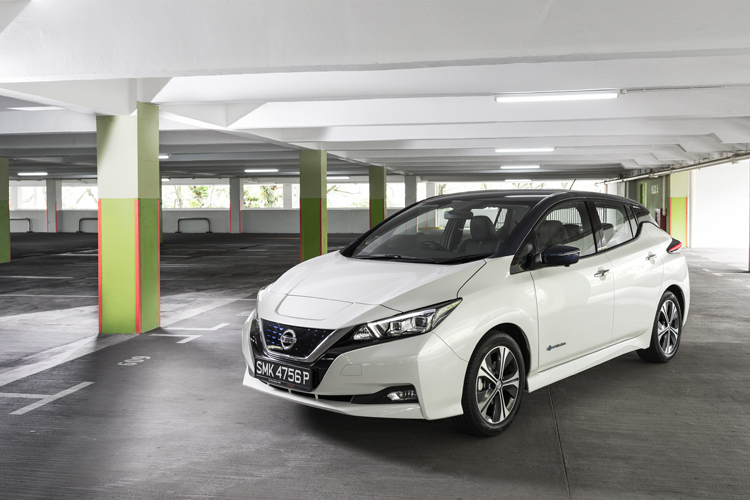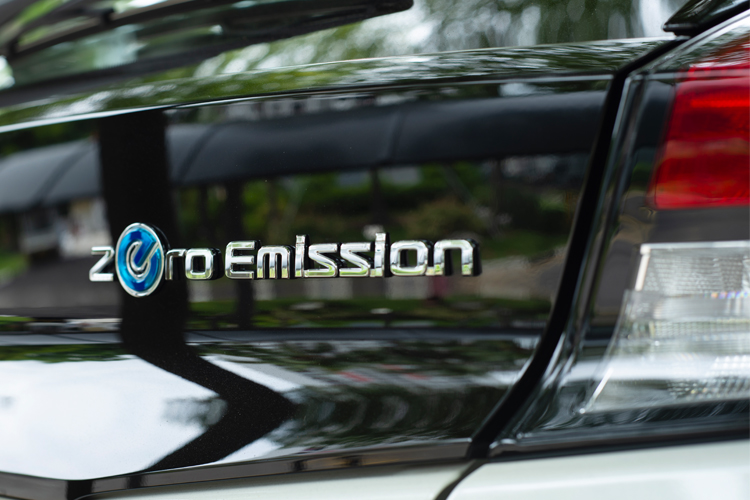
Torque contributor Tony Tan likes the Leaf’s roominess – there’s plenty of space for his pet doggies.
Surely 400,000 buyers can’t be wrong.
Yes, that’s the number of Nissan Leaf electric vehicles that have been sold since the first-generation model was launched in late 2010.
Back then, I was the only motoring journalist from Singapore who was invited to test drive the Leaf in Yokohama, Japan.
I came away very impressed with the car’s capability.
The only downside – its range.

During our drive around the factory’s test track, the Leaf’s display showed that I had a range of 60-65km remaining after just one hour.
And it wasn’t because I was piloting the car like a Formula 1 driver.
I can only imagine what it would have been like if I was driving the car back in Singapore.
The dreaded illness – range anxiety – which afflicted many an electric vehicle owner back then would have reared its ugly head extremely often.
The all-new Nissan Leaf won’t leave you anxious about its range at all.
While I couldn’t match Nissan’s claims of 311km, the Leaf’s display showed a maximum reading of 278km – that’s enough for four days of driving for me.

Leaf’s instrument panel is intuitive and can be read at a glance.
At the current rate of $0.2439 per kWh that is charged by SP Group, it’ll cost just $9.76 for the batteries to be charged to full capacity.
That’s 28.5km for every dollar!
Cost-wise, that’s (obviously) way more practical than any fossil fuel-guzzling car.
Mind you, with the plethora of companies offering cheaper rates for electricity nowadays, you’ll save even more money.
Getting the most mileage out of the Leaf’s batteries is made easier with the clever e-Pedal.

This stubby knob-like component is actually the gearshift lever, whose layout takes some getting used to.
When activated, all you need to propel, slow down or stop, is the accelerator pedal.
As you drive, a slight lift of the pedal is all that is needed to decelerate.
Lift your foot completely off and the Leaf comes to a complete stop.
I’ve to admit that the concept of single-pedal driving sounded quite scary at first.
But it took me all of five minutes to get used to the Leaf’s system – and it works great!

And don’t worry if a car pulls into your lane abruptly or brakes suddenly in front of you.
The emergency braking feature in the Leaf will automatically apply the brakes to help avoid a collision or lessen the severity of the impact.
Also, you can use the brake pedal at any time to switch back to “normal” driving.
For added assurance, the 360-degree camera with moving object detection feature makes manoeuvring around tight, crowded spaces a cinch.
In the Leaf, four driving modes are also available – D, D + Eco, B and B + Eco.

Leaf’s electric motor delivers 148hp and 320Nm at 0rpm, or in an instant.
The last two are for extended downhill driving (something you rarely encounter in Singapore).
D is for maximum performance with a highly responsive accelerator pedal.
For optimum range, D + Eco hits all the right spots.
The accelerator pedal becomes slightly muted while aircon settings are adjusted for added distance, but you’ll still stay comfortable.
The new Leaf is spacious.

With a wheelbase of 2690mm – just 15mm shorter than the larger X-Trail SUV – it seats five comfortably.
As the batteries are located beneath the rear seats, occupants at the back sit a little higher thus affording a commanding view of the front.
In fact, I could see almost the entire front windscreen when I plonked myself in the centre position.
There Leaf has numerous storage options that include a decently sized glove box and centre console compartment between the driver and front passenger.
Boot capacity is 435 litres – five litres more than the Qashqai SUV.

Fold down the Leaf’s rear seatbacks and storage increases to 1176 litres!
I could fit two full-suspension mountain bikes with consummate ease.
For all its many practical attributes, the one that shouts the loudest is the amount of money you will save as an owner of the new Nissan Leaf.
While the Leaf is pricier than a non-electric hatchback of similar size and attributes, you’ll make back the extra amount you forked out in a couple of years.
Then it’s more money in the bank after that.
Nissan Leaf review: Zippy performance
Nissan Leaf review: Electrifying engineering
NISSAN LEAF
DRIVETRAIN
BATTERY 40kWh lithium-ion
MOTOR Single front-mounted synchronous electric
MAX POWER 148hp at 3283-9795rpm
MAX TORQUE 320Nm at 0-3283rpm
POWER TO WEIGHT 72.4kW per tonne
GEARBOX Single-speed constant ratio
DRIVEN WHEELS Front
PERFORMANCE
0-100KM/H 7.9 seconds
TOP SPEED 140km/h
CONSUMPTION Estimated 5.8km/kWh (combined)
RANGE 311km
SUSPENSION
FRONT MacPherson struts, coil springs
REAR Torsion beam, coil springs
BRAKES
FRONT / REAR Ventilated discs / Discs
TYRES
TYPE Dunlop Enasave EC300
SIZE 215/50 R17
SAFETY
AIRBAGS 6
TRACTION AIDS ABS, VSC
MEASUREMENTS
LENGTH 4480mm
WIDTH 1790mm
HEIGHT 1540mm
WHEELBASE 2690mm
KERB WEIGHT 1490kg
TURNING CIRCLE 11m
BUYING IT
PRICE $160,300 with COE
WARRANTY 5 years/unlimited km (vehicle); 8 years/160,000km (battery)
+ Easy driving with the e-Pedal, spacious boot, sleek styling
– Pricey, comparatively smaller range, cheap interior















